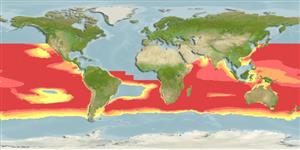Elasmobranchii (tubarões e raias) (sharks and rays) >
Squaliformes (Sleeper and dogfish sharks) >
Dalatiidae (Sleeper sharks)
Etymology: Euprotomicrus: eu-, a Greek intensive (i.e., very); protos (Gr.), first; mikros (Gr.), small, referring to very small first dorsal fin. (See ETYFish); bispinatus: bi-, from bis (L.), two; spinatus (L.) thorny, referring to spiny processes on each pelvic fin (claspers) of the male. (See ETYFish).
More on authors: Quoy & Gaimard.
Environment: milieu / climate zone / depth range / distribution range
Ecologia
marinhas batipelágico; intervalo de profundidade 0 - 1800 m (Ref. 31367). Deep-water; 38°N - 54°S
Circumglobal: In subtropical to temperate waters. Southeast Atlantic: near Ascension Island, east of Fernando de Noronha Island, and west of Cape of Good Hope, South Africa. Indian Ocean: Madagascar to Western Australia. North Pacific: Midway Islands, Hawaiian Islands to off California, USA. South Pacific: between New Zealand, Phoenix Island and southern Chile.
Comprimento de primeira maturação / Tamanho / Peso / Idade
Maturity: Lm 22.5, range 22 - 23 cm
Max length : 30.5 cm TL macho/indeterminado; (Ref. 96339)
Espinhos dorsais (total) : 0; Espinhos anais: 0. Small dogfish with a cigar-shaped body, a distinct dark collar marking around the gill region, a conical snout, large round eyes (Ref. 5578), fleshy lips, enlarged triangular lower teeth, equal-sized gill slits (Ref. 5578), very small dorsal fins, and a paddle-shaped caudal fin with nearly symmetrical upper and lower lobes (Ref. 6871). Black with white fin edges; belly luminous (Ref. 247).
Epi-, meso-, and perhaps bathypelagic at 1->400 m (Ref. 58302). Occurs at or near the surface at night, descending to below 400 m (possibly as deep as 1,800 m) during the day (Ref. 31367). Feeds on squid, bony fishes, and crustaceans (Ref. 5578). Ovoviviparous (Ref. 205), with 8 young per litter, size at birth between 6 and 10 cm (Ref. 247). Caught with dip-nets and buckets at night (Ref. 6577).
Ovoviviparous, with 8 young per litter. Size at birth between 6 and 10 cm (Ref. 247). Distinct pairing with embrace (Ref. 205).
Compagno, L.J.V., 1984. FAO Species Catalogue. Vol. 4. Sharks of the world. An annotated and illustrated catalogue of shark species known to date. Part 1 - Hexanchiformes to Lamniformes. FAO Fish. Synop. 125(4/1):1-249. Rome, FAO. (Ref. 247)
Status na Lista Vermelha da UICN (Ref. 130435)
Ameaça para os humanos
Harmless
Uso pelos humanos
Pescarias: sem interesse
Ferramentas
Relatórios especiais
Baixar XML
Fontes da internet
Estimates based on models
Preferred temperature (Ref.
123201): 5.7 - 15.3, mean 9.2 °C (based on 870 cells).
Índice de diversidade filogenética (Ref.
82804): PD
50 = 1.0020 [Uniqueness, from 0.5 = low to 2.0 = high].
Bayesian length-weight: a=0.00372 (0.00141 - 0.00976), b=3.12 (2.89 - 3.35), in cm total length, based on LWR estimates for this (Sub)family-body shape (Ref.
93245).
Nível Trófico (Ref.
69278): 4.1 ±0.4 se; based on diet studies.
Resiliência (Ref.
120179): Muito baixo(a), tempo mínimo de duplicação da população maior que 14 anos (Fec=8).
Fishing Vulnerability (Ref.
59153): Low vulnerability (21 of 100).
